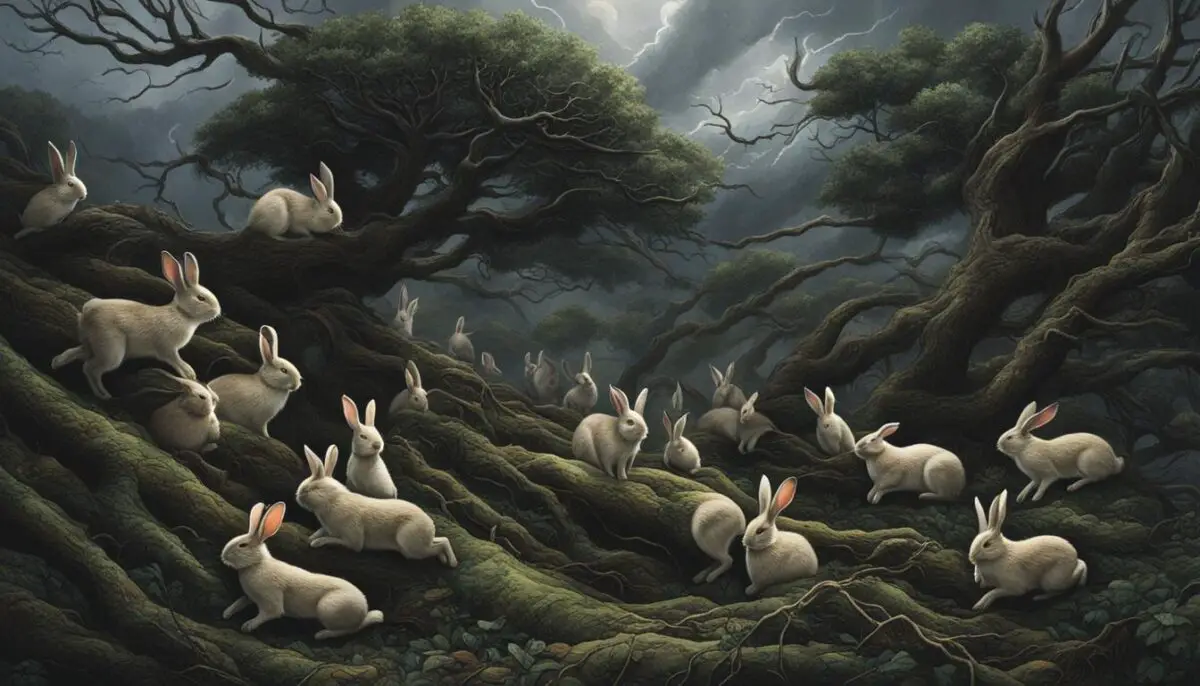Welcome to an enchanting journey filled with mischief and mayhem! Join us as we delve into the captivating world of “The Rabbits Who Caused All the Trouble,” a delightful fable penned by the renowned author James Thurber. Published in The New Yorker in 1939 and later included in his book “Fables for Our Time,” this modern fable takes us on a thought-provoking adventure where mischievous rabbits and troublemaking abound.
In this whimsical tale, a family of rabbits finds themselves at the center of various disasters, all blamed on their mischievous antics. But is there more to this story than meets the eye? Join us as we uncover the hidden depths and timeless lessons hidden in the misadventures of these troublesome rabbits.
Key Takeaways:
- Discover the amusing tales of mischievous rabbits causing all the trouble
- Explore the themes of prejudice, persecution, and escapism in the fable
- Learn valuable lessons about empathy, unity, and standing up against injustice
- Uncover the historical and contemporary relevance of the fable’s message
- Reflect on similar situations in history where minorities faced persecution
Rabbits Who Caused All the Trouble
The Characters in the Fable
In James Thurber’s fable, “The Rabbits Who Caused All the Trouble,” the story revolves around two main groups of characters: a family of rabbits and a pack of wolves. The rabbits, who are the central focus of the story, are portrayed as mischievous troublemakers who are blamed for various disasters by the wolves.troublemaking rabbits
The family of rabbits consists of individual members who each contribute to the narrative in their own way. While the rabbits themselves are not given specific names, they collectively represent a persecuted minority that is unfairly targeted by the wolves. Their actions and interactions within the story highlight the themes of injustice and prejudice.
The pack of wolves, on the other hand, serves as the antagonist in the fable. They harbor a strong prejudice against the rabbits and seek to “civilize” them by imposing rules and restrictions. The wolves’ discriminatory behavior towards the rabbits demonstrates the dangers of prejudice and the abuse of power.
The Characters in the Fable
| Rabbits | Wolves |
|---|---|
| The troublemaking family | The prejudiced antagonists |
| Represent a persecuted minority | Symbolize the majority’s prejudice |
| Blamed for various disasters | Seek to “civilize” the rabbits |
“The Rabbits Who Caused All the Trouble” is a story that showcases the conflict between the rabbits and the wolves. While the story primarily focuses on the experiences of the rabbits, there are also other nameless animals who provide support and advice to them throughout their journey. These supporting characters offer guidance and encouragement to the rabbits, serving as a reminder that there is strength in unity and standing up against injustice.”
The dynamic between the family of rabbits and the pack of wolves forms the foundation of the fable’s narrative. It highlights the importance of empathy, understanding, and challenging prejudice in order to create a more inclusive and just society. Through their interactions, the fable explores the consequences of discrimination and the power of unity in the face of adversity. trouble-causing rabbits
Table 1: Characters in the Fable
- Rabbits:
- The troublemaking family
- Represent a persecuted minority
- Blamed for various disasters
- Wolves:
- The prejudiced antagonists
- Symbolize the majority’s prejudice
- Seek to “civilize” the rabbits
Quote: “There is strength in unity and standing up against injustice.”
Plot Summary of the Fable
In the fable, the pack of wolves blames the family of rabbits for various disasters that occur in their community. The rabbits, portrayed as innocent bystanders, become the scapegoats for the wolves’ misfortunes. Despite the unfair accusations, the rabbits decide to flee to a nearby desert island in an attempt to escape the persecution. rabbits causing chaos
However, other animals in the story intervene and convince the rabbits to stay and face their fears. They encourage the rabbits to be brave and stand up against the unjust blame placed upon them. The rabbits heed this advice and continue to reside in their community, facing the wolves’ prejudice head-on.
As the fable progresses, a flood occurs in the community, leading the wolves to imprison the rabbits for their own protection. The wolves spread the false narrative that the rabbits had been eaten during the flood, further perpetuating the prejudice against them. The other animals, witnessing this injustice, demand an explanation for the imprisoning of the innocent rabbits. rabbits creating problems

Summary of the plot:
- The wolves blame the rabbits for various disasters.
- The rabbits consider fleeing to a desert island.
- Other animals convince the rabbits to stay and be brave.
- A flood occurs, and the wolves imprison the rabbits.
- The wolves claim the rabbits were eaten, and the other animals demand an explanation.
| Event | Characters Involved |
|---|---|
| Wolves blaming rabbits | Wolves, Rabbits |
| Rabbits considering fleeing to an island | Rabbits, Other Animals |
| Other animals convincing rabbits to stay | Rabbits, Other Animals |
| Flood occurring | All characters |
| Wolves imprisoning rabbits | Wolves, Rabbits |
| Wolves claiming rabbits were eaten | Wolves |
| Other animals demanding an explanation | Other Animals |
Major Themes in the Fable
In James Thurber’s fable “The Rabbits Who Caused All the Trouble,” several major themes come to the forefront, shedding light on important societal issues. One of the prominent themes explored in the fable is prejudice. The wolves’ irrational hatred and prejudice against the rabbits symbolize the dangers of discrimination and the harmful consequences it can have on innocent individuals or groups. troublesome antics of rabbits
Persecution is another significant theme depicted in the fable. The rabbits, representing a persecuted minority, face unfounded blame and persecution for various disasters caused by natural occurrences. This theme reflects the historical context of the Second World War, during which many minorities were unjustly targeted and mistreated.
The fable also delves into the concept of escapism. The rabbits’ initial instinct to flee to a desert island to escape the wolves’ persecution highlights the temptation to avoid difficult situations. However, other animals in the story encourage the rabbits to stay and face their challenges with courage. This theme serves as a reminder that running away from problems is not a sustainable solution and that it is essential to confront adversity head-on.rabbit mischief
The Power of Unity
An additional theme that emerges in the fable is the power of unity. The other animals in the story, despite not being directly involved in the conflict between the rabbits and the wolves, advocate for the rabbits and demand an explanation for their disappearance. This theme emphasizes the importance of standing up against injustice and demonstrates the strength that can be found in unity and solidarity.
Overall, “The Rabbits Who Caused All the Trouble” provides a thought-provoking exploration of themes such as prejudice, persecution, and escapism. Through its compelling narrative, the fable urges readers to reflect on these issues and consider the significance of empathy, standing up against injustice, and the impact of unity in addressing societal challenges.
| Themes in the Fable | |
|---|---|
| 1 | Prejudice |
| 2 | Persecution |
| 3 | Escapism |
| 4 | The Power of Unity |
Popular Culture References
The fable of “The Rabbits Who Caused All the Trouble” has not only captivated literary enthusiasts but has also made its way into popular culture. One notable mention is the renowned television broadcaster Keith Olbermann, who read the story on his program “Countdown with Keith Olbermann.”
Olbermann, in a heartfelt tribute to his father who cherished James Thurber’s stories, chose to share this fable with his audience. By showcasing the enduring message of the tale, Olbermann brought attention to the timeless themes of prejudice, persecution, and the importance of empathy.
“The Rabbits Who Caused All the Trouble” continues to resonate with audiences across generations, emphasizing the enduring relevance of Thurber’s work.”
Through Olbermann’s reading, this fable reached a wider audience, sparking conversations about the consequences of irrational prejudice and the power of standing up against injustice. It serves as a testament to the impact that literature can have on society and its ability to provoke thoughtful analysis.
| Popular Culture Reference | Description |
|---|---|
| Keith Olbermann’s Reading | Televised reading of the fable on “Countdown with Keith Olbermann,” paying tribute to James Thurber’s work and highlighting its enduring message of prejudice and unity. |
Analysis and Interpretation
The fable “The Rabbits Who Caused All the Trouble” can be analyzed as a political allegory, with the rabbits representing persecuted minorities and the wolves symbolizing the majority’s prejudice and discrimination. The story’s themes reflect the historical context of the Second World War and the atrocities committed during that time. By exploring these themes, the fable serves as a reminder of the importance of empathy, unity, and standing up against injustice in society.
“The Rabbits Who Caused All the Trouble” portrays the rabbits as innocent victims of prejudice and scapegoating. The wolves, driven by irrational beliefs, blame the rabbits for various disasters without any evidence. This mirrors the unjust persecution faced by minority groups throughout history, where innocent individuals or communities are targeted and held responsible for societal problems. Through this allegory, the fable reveals the dangers of prejudice and discrimination, urging readers to question and challenge such biases.
The fable’s historical context adds depth to its interpretation. Written during the Second World War, when minority groups were subjected to widespread persecution and human rights abuses, the story serves as a powerful commentary on the social and political climate of that time. By emphasizing the plight of the rabbits and the wolves’ animosity towards them, the fable draws attention to the injustices faced by marginalized communities and the need for unity and solidarity in the face of oppression.
Political Allegory and Historical Context
The fable’s political allegory and historical context provide insight into the human experience of prejudice and persecution. It prompts readers to examine their own biases and consider the ways in which prejudice can divide societies and inflict harm on innocent individuals. By highlighting the historical backdrop of the Second World War, the fable serves as a poignant reminder of the importance of empathy, understanding, and the commitment to justice for all.
The Dangers of Prejudice and the Power of Unity
James Thurber’s fable “The Rabbits Who Caused All the Trouble” serves as a powerful reminder of the dangers of prejudice and discrimination. Through the story of the persecuted rabbits and the irrational hatred of the wolves, the fable highlights the damaging effects of unfounded beliefs and the scapegoating of innocent individuals.
The fable teaches us that prejudice can have far-reaching consequences, leading to the persecution of marginalized communities. It illuminates how irrational biases can be used to justify unfair treatment and discrimination. By blaming the rabbits for various disasters without evidence, the wolves perpetuate a cycle of fear and hatred.
However, the fable also underscores the power of unity and standing up against injustice. It showcases the bravery of the other animals who support and encourage the rabbits to resist persecution. The story emphasizes that it is only through collective action and a refusal to succumb to escapism that true change can be achieved.
“In a world where prejudice and discrimination still persist, Thurber’s fable reminds us of the importance of empathy, unity, and challenging unfair treatment. It prompts us to reflect on our own beliefs and behaviors, urging us to stand up against injustice and support those who are marginalized or unfairly targeted.”
As we consider the lessons from “The Rabbits Who Caused All the Trouble,” we are reminded of the ongoing fight against prejudice in our own society. It prompts us to examine our own biases and actively work towards creating a more inclusive and equitable world. By recognizing the dangers of prejudice and embracing the power of unity, we can contribute to positive change and ensure a better future for all.

Lessons from the Fable:
- Prejudice can lead to the scapegoating and persecution of innocent individuals or groups.
- Discrimination is based on unfounded beliefs and can have far-reaching consequences.
- Unity and collective action are essential in standing up against injustice.
- Escapism is not a solution; it is necessary to confront difficult situations.
Similar Situations in History
James Thurber’s fable “The Rabbits Who Caused All the Trouble” resonates with the experiences of persecuted minorities throughout history. The fable’s themes of prejudice and discrimination can be seen in numerous historical contexts, serving as a reminder of the need for empathy and justice.
One such example is the persecution of Jewish people during the Holocaust. Just as the rabbits in the fable are unfairly blamed for disasters, Jews were scapegoated and targeted by the Nazi regime. The fable’s message of standing up against injustice aligns with the importance of acknowledging and challenging the systemic discrimination that led to the Holocaust.
The civil rights movement in the United States also mirrors the themes of the fable. African Americans faced widespread prejudice and discrimination, much like the rabbits in Thurber’s story. The fight for equal rights and the power of unity are central to both narratives, highlighting the ongoing struggle for racial equality.
Furthermore, the fable’s lessons are relevant to contemporary issues of systemic inequality and racial injustice. From the Black Lives Matter movement to ongoing debates about immigration and religious discrimination, the fable serves as a reminder of the dangers of prejudice and the importance of recognizing and challenging it in all its forms.
By examining historical and modern instances of persecution, “The Rabbits Who Caused All the Trouble” provokes thoughtful analysis and encourages readers to reflect on the ongoing fight for equality and justice.

Conclusion
In James Thurber’s fable “The Rabbits Who Caused All the Trouble,” the mischievous actions of the rabbits and the irrational prejudice of the wolves serve as a powerful exploration of prejudice, persecution, and the power of unity. Through this timeless fable, Thurber highlights the importance of empathy, standing up against injustice, and resisting the temptation of escapism.
Thurber’s fable, featured in his book “Fables for Our Time,” remains relevant today, offering valuable lessons that can be applied to both historical and contemporary situations. It reminds us of the dangers of prejudice and discrimination, urging readers to recognize and challenge these biases in all their forms. The story also emphasizes the power of unity and the importance of not succumbing to the allure of escapism when faced with difficult circumstances.
With its enduring message and thoughtful insights, “The Rabbits Who Caused All the Trouble” stands as a testament to Thurber’s ability to capture complex themes in a simple and engaging manner. It continues to resonate with audiences, reminding us of the need for empathy, unity, and the courage to confront injustice in our world.
FAQ
What is the title of the fable?
The title of the fable is “The Rabbits Who Caused All the Trouble.”
Who wrote the fable?
The fable was written by James Thurber.
When was the fable first published?
The fable was first published in The New Yorker in 1939.
What is the main theme of the fable?
The main themes of the fable are prejudice, persecution, and escapism.
What are the major characters in the fable?
The major characters in the fable are a family of rabbits and a pack of wolves.
What are some popular culture references to the fable?
One popular culture reference is television broadcaster Keith Olbermann reading the story on his program “Countdown with Keith Olbermann.”
What are some similar situations in history that the fable relates to?
The fable can be related to historical situations such as the treatment of Jewish people during the Holocaust and the civil rights movement in the United States.
What lessons can be learned from the fable?
The fable teaches valuable lessons about the dangers of prejudice and discrimination, as well as the power of unity and standing up against injustice.
What is the significance of the fable’s historical context?
The fable reflects the historical context of the Second World War and serves as a reminder of the atrocities committed during that time.
Who is the author of the fable?
The author of the fable is James Thurber.


